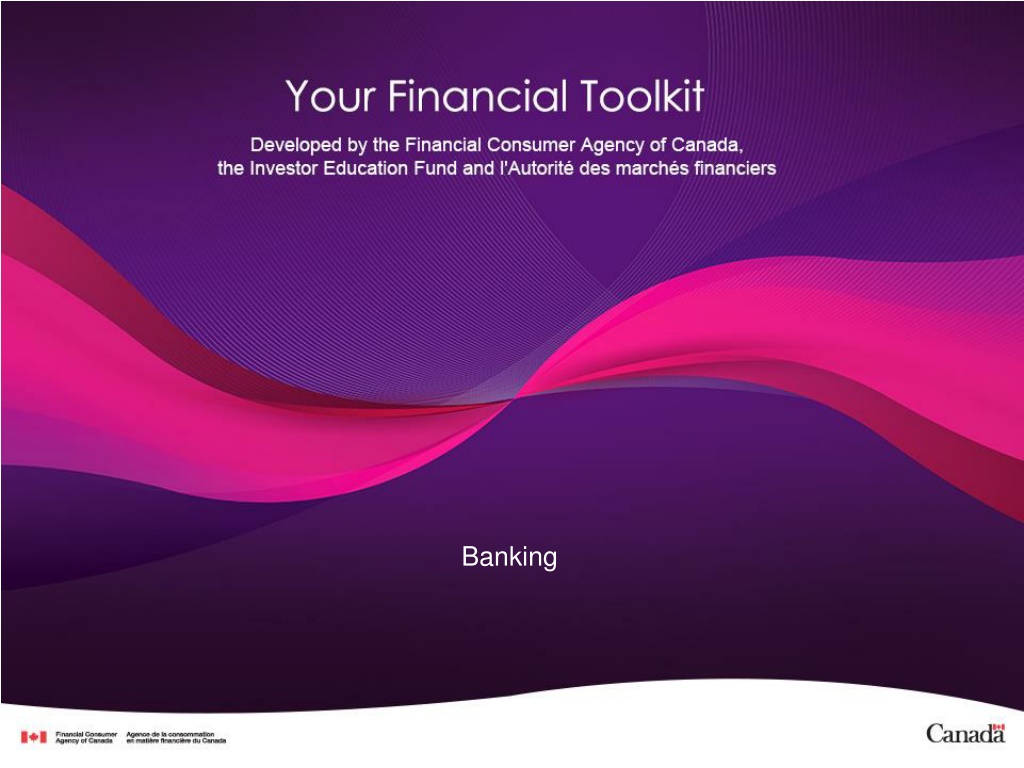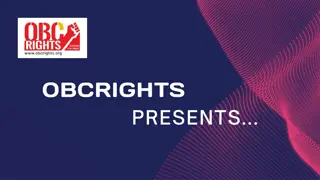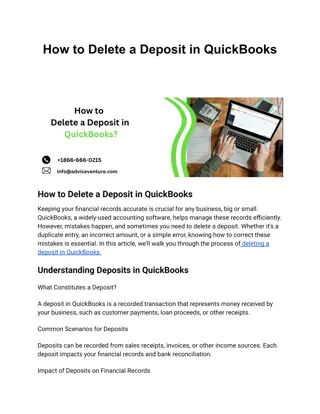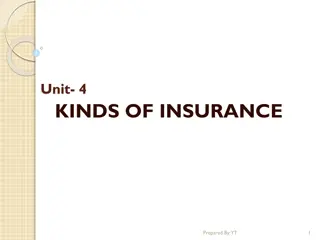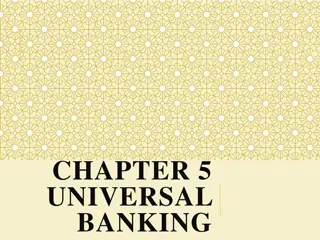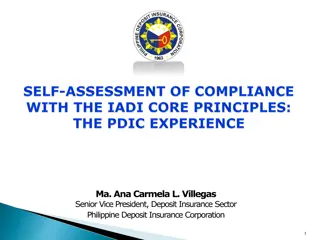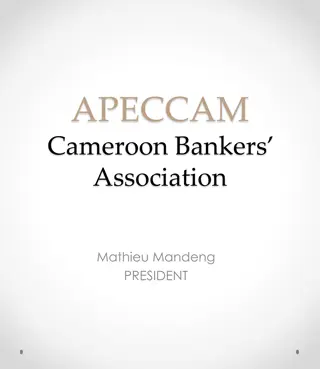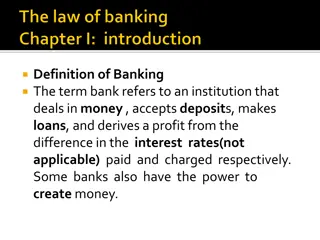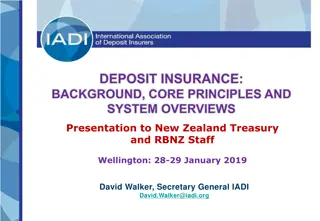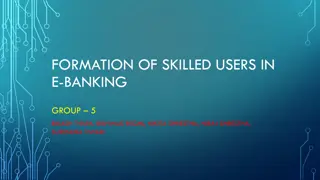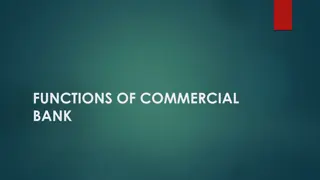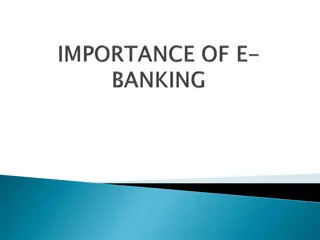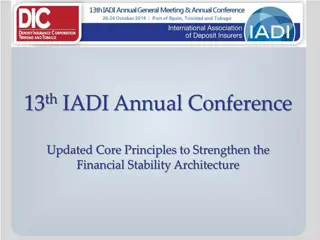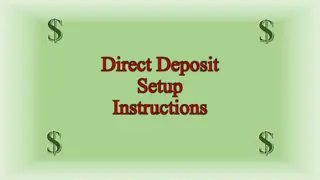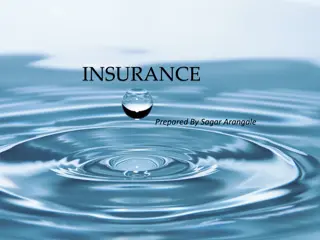Understanding Basic Banking Services and Deposit Insurance
This module covers the fundamental services offered by financial institutions, guidance on selecting the right banking account, understanding rights and responsibilities, ensuring the safety of accounts, and taking action against potential unauthorized account use. It also explains basic banking services like deposits and card services, the role of deposit insurance in protecting deposits, various banking services available for daily needs, and ways to conduct banking operations. Considerations for future financial planning, such as automatic transfers to savings accounts, are also highlighted.
Download Presentation

Please find below an Image/Link to download the presentation.
The content on the website is provided AS IS for your information and personal use only. It may not be sold, licensed, or shared on other websites without obtaining consent from the author. Download presentation by click this link. If you encounter any issues during the download, it is possible that the publisher has removed the file from their server.
E N D
Presentation Transcript
Agenda Start time: ____ Break time: ____ (10 minutes) End time: ____ Please set phones to silent ring and answer outside of the room.
Banking This module covers: The basic services that financial institutions offer How to choose the type of banking account you need What your rights and responsibilities are when using a financial institution How to keep your accounts safe What to do if you think someone may be using your account illegally
Basic banking This section covers: Basic banking services, such as deposits and card services How the deposit insurance system keeps your deposits safe How to use banking services for your everyday needs
Banking services Banks, credit unions, caisses populaires and trust companies offer: Deposit services Card services Loans And other services
Deposit insurance Protects depositors if insured institution cannot return deposits. Different deposit insurance systems: o One for institutions regulated by federal government o Others for institutions regulated by province or territory Check which insurance system applies to your deposit and what the insurance limits are.
Ways to do your banking Financial institutions offer you many different ways to do your banking, these are: In person By phone By Internet or mobile device By automated teller machine By debit card reader (point-of-sale terminal or POS)
Banking for your future Consider automatic transfers to your savings account. This helps you: Save for emergencies Prepare for big expenses Start on long-term savings and investments
Summary of key messages Deposit institutions include banks, credit unions, caisses populaires and trust companies They help you manage your money and keep it safe Main services include deposits, debit card services and loans Services are available: o In person o Online by phone or mobile o Through automated teller machines
Banking accounts and packages This section covers: The main features of chequing and savings accounts The interest paid and how it affects your savings The account fees you ll pay and how to reduce them How to read your account statement
Savings accounts Pay higher rate of interest May not offer debit card or chequing May have fees on basic transactions May have limit on number of free transactions May require one or more days to transfer money Best for money you won t need for day-to-day expenses
Chequing accounts Pay lower interest, or none at all Include debit cards and chequing May offer basic services at no fee Usually allow more free transactions Minimize delay for withdrawals, transfers and cheques May offer special rates for certain groups Best for day-to-day banking
Interest Interest paid on your accounts adds to your savings. Savings accounts normally pay compound interest: Interest on interest previously paid into your account Some investments pay simple interest: Interest is calculated on the original amount only
Manage your fees Manage your account fees to reduce your banking costs. Watch how many transactions you make Use the cheapest method to do your banking Get only the records you really need Watch your account balance Ask for special fees based on your age or minimum balance Negotiate for lower fees
Summary of key messages Pick a convenient location Get only the services you need Pick the account with the lowest fees for the services you need Compare rates before you open an account Check your account statements every month
Alternative financial arrangements Alternative financial arrangements include: Payday loans Cheque-cashing services Finance companies Unregistered services in ethnic communities
Risks of alternative financial arrangements They are not regulated like banks They offer less security They often charge higher fees Read about Payday loans
Your rights and responsibilities This section covers: Your rights when you use a regulated financial institution The responsibilities you have to keep your account secure How to make a complaint about a financial institution
Consumer rights Right to open an account when you present the correct ID in person Many banking institutions offer a basic chequing account for $4/month Right to information about your account in writing Right to cash government cheques for free
Your responsibilities Read and understand account agreement Check your account statement regularly Report anything you think is not right Keep your account documents, passwords and PINs secure
The debit card code A voluntary code that protects you when you use debit card services in Canada. You must: Choose a PIN that is hard to guess Keep your PIN secure Check your account statements Report problems to your financial institution For full details, go to the Financial Consumer Agency of Canada s information on the Canadian Code of Practice for Consumer Debit Card Services.
Making complaints Financial institutions must have a way for customers to make complaints. Step 1: Discuss problems with local branch Step 2: Ask for review by senior bank official Step 3: Ask for review by an independent official Contact federal, provincial or territorial regulator For more information, contact FCAC.
Summary of key messages You have rights at your financial institution You can complain if your rights are not honoured Independent officers can help
Banking and fraud This section covers: How debit card fraud happens How to protect yourself from debit card fraud What to do if you are a victim of debit card fraud
Debit card fraud Debit card fraud can happen with: An altered card reader or ATM A thief who watches you enter your PIN A separate card reader A stranger who steals your card and PIN
Protect yourself from debit card fraud Debit card tips: Choose a PIN that s hard to guess Hide your PIN and don t share it Keep your debit card in a safe place Don t lend your card Swipe your card yourself (or watch it) Notify the card issuer if: o Your card stops working o Your statement shows a purchase you didn t make o Your statement does not show a purchase you did make
If you are a victim of fraud If your card or PIN has been stolen or compromised: Contact the company that issued the card Contact your local police Contact Canada s two main credit bureaus: o Equifax Canada (www.equifax.ca) o TransUnion Canada (www.transunion.ca) For more information, go to FCAC's page on Debit card fraud.
Summary of key messages Stay alert to fraud, it can happen to you Keep card, PIN and other information secure and confidential If you become a victim, tell the company that issued the card and the police
